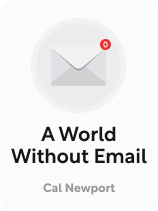

This article is an excerpt from the Shortform book guide to "A World Without Email" by Cal Newport. Shortform has the world's best summaries and analyses of books you should be reading.
Like this article? Sign up for a free trial here.
What is the hyperactive hive mind? What causes this mindset?
Cal Newport’s book A World Without Email describes the term “hyperactive hive mind workflow” (HHMW). This is where all members of an organization are in constant, frantic, and often unnecessary communication.
Let’s look at the four factors that create and drive the hyperactive hive mind workflow.
Factor #1: Fear of Alienation From Your Group
Because social connection is evolutionarily critical to human survival, failing to maintain it—even via email—feels terrible. This sense that you’re neglecting someone keeps you glued to your inbox to not alienate yourself from others.
(Shortform note: In Digital Minimalism, Newport further argues that digital communication—which we feel to be so critical to our social connectivity—not only feeds the hyperactive hive mind workflow, but isn’t even a rich form of social interaction in the first place. This is because, while in-person interactions require you to be empathetic and allow you to feel understood in return, digital conversations imply none of this. Thus, when you compulsively check your inbox in an effort to be connected, you’re only building superficial connections—you’re not reinforcing meaningful relationships.)
Factor #2: The Misconception That Asynchronous Communication Is Easier
Additionally, Newport writes that most workers think asynchronous communication (communication that doesn’t require both parties to respond at the moment) is easier and more efficient than synchronous (talking in person, for instance), but it’s not: Asynchronous communication extends the time a conversation takes because it requires many more messages to be exchanged. For instance, setting up a meeting verbally might take two minutes, while setting up a meeting via email could require a dozen emails. This reliance on asynchronous communication makes the HHMW almost unavoidable.
(Shortform note: While asynchronous communication can indeed be less efficient than synchronous, others argue that asynchronous communication has the benefit of letting workers set boundaries on communication more easily than synchronous communication. This is because a worker can decide when to respond to an email or message, but it’s harder for them to decide not to answer a call or a visit from a colleague.)
Factor #3: Pressure to Be Increasingly Responsive
When time-saving technology becomes available, there’s increased pressure for you to use it to respond more quickly and at all hours of the day, thus perpetuating the HHMW, writes Newport. Harvard Business School professor Leslie Perlow calls this phenomenon the cycle of responsiveness: When the technology to deliver more is available, clients and co-workers expect more of you, and you work more to meet those expectations.
(Shortform note: In an article on the cycle of responsiveness, Perlow adds that once you enter this cycle, you become so entrenched in it—so busy responding to faster-arriving requests—that you don’t have the mental energy to consider better ways to do your work. What’s more, this cycle of responsiveness often causes you to work outside of working hours, thus not only decreasing the quality of your work output, but also the quality of your leisure time.)
Factor #4: Our Conception of the Knowledge Worker
According to Newport, the final catalyst of the hyperactive hive mind workflow is the way we view today’s knowledge worker—a view shaped by famed management consultant Peter Drucker, who coined the term in 1959. He believed that knowledge workers must be left to their own devices to complete the work in which they specialized and which they likely knew how to do better than their superiors. This means companies give knowledge workers free rein over how to structure their days, thinking this to be most efficient.
However, this freedom also means there are no guidelines for how much time knowledge workers must spend performing ancillary tasks, like responding to emails and messages. Because knowledge workers are usually part of a team that relies on their input and, as discussed above, feel an evolutionary need to support that team, they spend a disproportionate amount of time responding to their team’s messages.
Peter Drucker on Managing Your Time as a Knowledge Worker
It seems that we’ve taken only half of Drucker’s advice about knowledge workers—to our detriment. While Drucker does advocate that knowledge workers be autonomous (the advice the business world seems to have heeded), he also advocates that knowledge workers manage their time carefully, analyzing it, eliminating unproductive work, and setting up blocks of time for knowledge work. This is advice companies and knowledge workers haven’t heeded.
Drucker’s advice can help keep workers from slipping into the hyperactive hive mind workflow, but its effectiveness will be limited if those workers don’t also have support from their organizations in their efforts. Let’s look at how organizations can support workers in their personal quest to manage their time.
- Analyze your time: Drucker first advises jotting down what you do all day and how long each task takes. Bringing awareness to how you spend your time could be a logical first step toward tackling the HHMW, which is perpetuated by a lack of intentionality: responding impulsively to whatever request comes up. Companies can support workers in doing this by ensuring they have enough time to perform this analytical work.
- Eliminate time-wasting activities: Drucker’s next step is to stop doing tasks that don’t generate the knowledge work you were hired to do. Companies can help workers do this by hiring support staff or allowing workers to redefine their roles to involve less admin work.
- Make room for chunks of knowledge work time: Drucker finally recommends scheduling four- to five-hour chunks of uninterrupted time to perform knowledge work. Managers can help workers do this by encouraging knowledge workers to go completely offline during this time or setting up out-of-office responses.

———End of Preview———
Like what you just read? Read the rest of the world's best book summary and analysis of Cal Newport's "A World Without Email" at Shortform.
Here's what you'll find in our full A World Without Email summary:
- How email makes knowledge workers less productive and more unhappy
- How to improve the channels through which people communicate
- Why you should implement protocols to reduce unnecessary work






